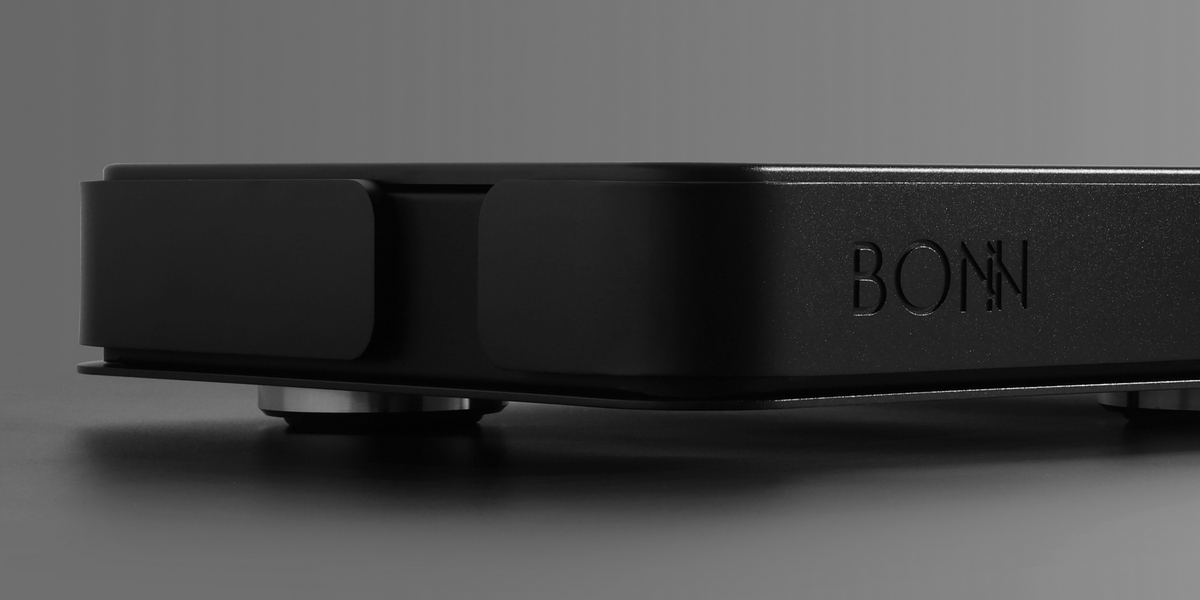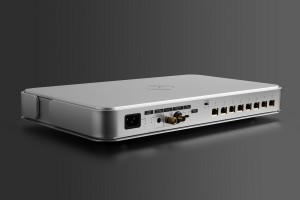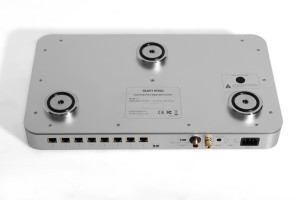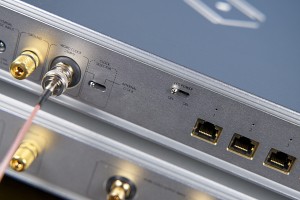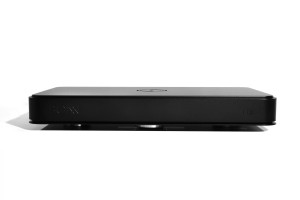Silent Angel emerged on the market only a few years ago offering products for modern audiophiles partial to streaming music rather than using its traditional carriers. They started at lower price regions offering affordable solutions later moving up the ladder with their latest products clearly intended for the most demanding music lovers. For this test, we received their top LAN switch called Silent Angel Bonn NX.
Introduction
There is no doubt that music files streamed from local storage or web-based streaming services are the future of audio. Streaming is cheap, and millions of albums and tracks are available within just a few clicks. Initially, fans of streaming recruited mostly from young people, who listened to music on their phones and laptops, and also those who liked the convenience of this solution and were willing to sacrifice some sound quality for it. In other words, the story reminded that of a Compact Disc – they offered convenience compared to vinyl records at the cost of lower sound quality and it was enough to push the older medium off the market almost completely.
It took many years before both CDs and CD Players actually delivered sound quality rivaling that of vinyl records. Some even say that only within the last few years this technology achieved its pinnacle which would mean it took more than 30 years to perfect it. The story with files repeated to a point but it took less time to achieve a good sound with them. With the growing availability of high-resolution files and streaming services now offering hi-res files, higher quality streaming algorithms, and D/A Converters and streamers better suited for the job, the revolution took root also among audiophiles of all backgrounds and ages.
While many of us hopped on the „hi-res audio files” train rather quickly the initial results were not as good as we expected even when using high-resolution PCM or DSD files. For that to happen one more, already mentioned, ingredient was necessary – a way for music files to sound as good, or at least almost as good as physical carriers – CDs, vinyl records, SACDs, and so on. That was a job for the audio industry. There was enough knowledge and experience among long-existing audio brands to improve D/A Converters, develop LAN and USB cables, and in some cases even design streamers.
It also created an opportunity for new brands, often with solid roots in computer/IT/data streaming industries to use their specialized know-how to develop non-audio products for demanding audiophiles. The idea was to utilize the knowledge and experience in a slightly different way than they do in the IT industry and to offer products that could ultimately improve sound quality by providing a better quality signal, meaning one with less noise and lower jitter, for high-end DACs that feed high-end amplifiers driving high-end speakers. While some IT engineers will tell you that there is nothing to improve and data transfer ensures perfection, others accepted the challenge and developed products that help streaming break through the barrier separating its sound quality from that of classic audio signal carriers.
The idea of borrowing knowledge and experience from other industries isn’t that new either. After all, all the vibration damping/control products, grounding products, and so on, aren’t really ‘audio’ components. Many of them are actually industry-standard products customized or adapted for audio use. LAN switches, USB and LAN cables, grounding devices, or even linear power supplies or computers used as music servers were also not invented but rather adapted for audio purposes to satisfy a demand that the latest streaming revolution created. In many cases, such products have been developed by people who have a lot of experience in computer or data transmission-related jobs and who also happened to be audiophiles themselves.
One such case is Silent Angel, a daughter company of Thunder Data Co. LTD. The latter’s business is server manufacturing, network communication, data management, network storage software, hardware engineering, and so on, in other words, this is a hi-tech company. They focus on 5G mobile networks and 8K video transmission, hence possess a lot of knowledge and experience related to data transmission even so demanding as required for high-resolution video. The company was founded by Dr. Eric Jian Huang (PhD degree in computer science) and for two other daughter brands that develop products for audio he paired with another engineer, Mr. Chorus Chuang, the company’s CTO. He is an engineer with a Masters Degree in Electrical and Electronics Engineering.
Both gentlemen are not only engineers but also audiophiles hence their common interest in developing products that would improve sound quality for streamed audio playback. They decided to use their specialized (widely understood) IT knowledge to develop products that would turn listening to streamed content into a truly audiophile experience. They started at relatively low price levels developing basic audiophile switches, and linear power supplies. Later came their music server, Z1, with a custom OS, and then more and more advanced models of switches and power supplies. The latest, respectively, are Bonn NX and Forester 2 that I got for this review, which are Silent Angel’s current top achievements, as well as Genesis GX word clock.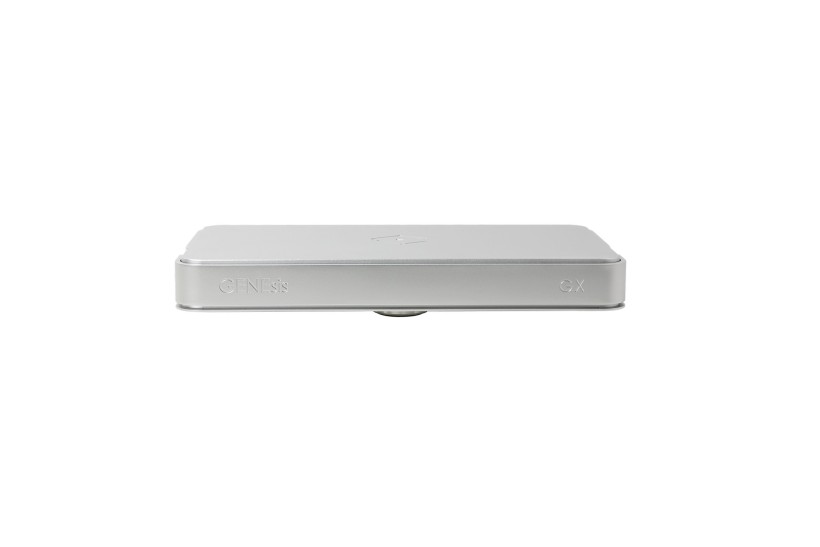
My own path into the world of streaming started with a custom-made server that I quickly upgraded replacing standard switching mode power supply with a linear one. A performance improvement was significant enough that there was no way back for me. Then came the optical LAN isolator, JCAT USB, and NET cards for my server (ultimately replaced by their top XE models – you can find the review HERE), David Laboga Custom Audio’s LAN and USB cables (see HERE, HERE, and HERE), Ferrum Hypsos Signature hybrid power supply (see HERE) for the USB and NET cards, a separate linear power supply for NAS, and last but not least Bonn N8 switch with Forester 1 linear power supply from Silent Angel. All these components contributed to achieving a sound quality with audio files that was good enough for me not to even use a CD Player anymore. My custom server together with LampizatOr Pacific (now upgraded to version 2, which I highly recommend!) DAC and J.Sikora turntable are two reference sources that serve me in all of my reviews and my private explorations of the world of music.
Does it mean, that it can’t get any better? Not at all. Not that long ago I tested Silent Angel Bonn N8 PRO switch with Forester 2 power supply, and later the whole SA system including their Rhein Z1 server and E1 Expander. I had no doubts that N8 PRO outperformed my switch providing an even better sound quality (enabling the system to perform better, to be exact). That’s how I know it can get even better, my setup that is, it’s just a matter of further investment in carefully selected components.
Last year, at the Audio Video Show in Warsaw, I sat in the Silent Angel room and Mr. Chorus Chuang was kind enough to present advantages, or rather let me assess them, of their latest top switch, Bonn NX, alone and together with their precise word clock, Genesis GX. I was impressed even though the Show’s conditions were far from optimal to properly present the advantages of the top Silent Angel achievements. Now, some months later, both of these devices finally arrived at my doorstep and I could check them both, separately and combined for their influence on the performance of my own system.
Design and features
Until now, all previous Silent Angel switches looked like… standard switches. Well-build, but still not really up to the standards audio manufacturers got us audiophiles used to. To be clear – it’s not a complaint on my side or a weakness of these products, as basically, all manufacturers focused on the insides of such devices rather than on changing their form into something more pleasing to the eye. With Bonn NX (and Genesis GX) Silent Angel radically changes that approach. Now it’s a device that one can proudly place on the rack next to an amplifier, DAC, or any other audio component.
Feature-wise it is still an 8-port Gigabit switch. The „audiophile” nature on the outside is revealed first of all by elegant, aluminum chassis with the name of the model engraved on the front. The second element is nice anti-vibration feet made of stainless steel combined with rubber (I believe) O-rings. The rear panel hosts eight gold-plated gigabit ports that are also properly spaced so that, on the one hand, users won’t have problems plugging some audiophile LAN cables in, on the other, there is less interference between the ports.
There are also two power inlets – one is a standard IEC, and the other allows users to power the device using an external power supply via a DC cable. There is no switch to choose between the two – when you connect an external PS it is automatically selected which is confirmed by an LED indicator. On the rear panel, you will also find a ground post, a BNC connector that allows you to connect an external clock to the switch, a small toggle switch that lets you choose between an internal and external clock, and another one that turns on or off LEDs accompanying LAN ports. Both the BNC connector and ground post are gold-plated.
As for the chassis it actually consists of two layers – the one already discussed, external, aluminum one, which also shields the circuits inside against RFI and EMI. There is yet another, internal one, made of galvanized steel. According to the manufacturer such a design: „…maximizes shielding and control of eddy currents while damping vibration and noise.” The chassis design together with, as the manufacturer calls it, a „Class-leading Radar-Grade” internal switching power supply module is responsible for protecting signal transferred via Bonn NX from noise. The whole power supply circuit consists of several stages – a separate one for the in-build TCXO clock, and for the switch stage, and there is also an AC power filter. The other aforementioned issue that an audiophile-grade switch should resolve is jitter. The answer for that is a TCXO (Temperature Compensation Crystal Oscillator), and its job is to lower network latency issues and the jitter effect resulting from it.
Now, while it is a top-quality switch Silent Angel still offers users some options to improve its performance. One, due to the presence of the aforementioned ground post, is using one of the external so-called ground-conditioners offered by numerous companies. The other, despite using a high-grade switching power supply, still has an option of replacing it with an external one such as the company’s own Forester 2 linear power supply. And the third potential upgrade is an external word clock. Silent Angel currently offers one called Genesis NX that features the same class chassis as Bonn NX so the two look great together.
Does it all really matter? Can you actually hear the difference? I did hear the effect of using Genesis NX together with Bonn NX already at the Audio Video Show in Warsaw last year. Now, I got a chance to reevaluate my initial findings in my own system, as I got all three devices, Bonn NX, Forester 2, and Genesis NX at my disposal. In this test, I will try to assess an influence on the performance of my system of the switch itself, and the switch supported by Forester 2 linear power supply. Genesis NX deserves a separate review, although it will be tested together with Bonn NX and Forester 2.
Sound
It so happened that I had a chance to seek for benefits of using the Bonn NX with and without the support of Forester 2 linear power supply compared to the Bonn N8 paired Forester 1 using not only my reference setup but also the latest network transport by Ayon Audio, S10 II T. At first, I used the Bonn NX powered via IEC input from my Gigawatt PC3 SE EVO+ conditioner using LessLoss DFPC Signature power cable. Later, I switched it to the Silent Angel’s own top linear power supply, Forester 2. I left the assessment of the Genesis GX clock for a separate review.
Silent Angel Bonn NX
As I’ve already mentioned, I knew that Bonn N8 PRO outperformed the setup I’ve been using for quite some time (N8 + Forester 1). I also knew that the difference increased further after feeding the N8 PRO from Forester 2. So I expected to hear an even more improvement with NX replacing my set with or without an external power supply. And it did. First thing first, though. When comparing LAN switches or other similar devices used to improve the performance of audio components, it is always easier to notice the difference by getting used to the supposedly better sound and only then switching back to one’s own, supposedly inferior alternative. And so I did with Bonn NX. I plugged it in and kept it in the system for 3 days. Then I switched back to my own rig, and…
The first album, Jessica Williams’ „…And Then There’s This!” sounded really well played using both, my custom server with Roon and Ayon S10 II T transport paired with Pacific 2 DAC when using them with my regular switch. I had no particular complaints even knowing, that N8 PRO proved it could sound a bit better/deeper/more engaging. I listened to it using Bonn NX and it seemed to me as if the sound got… more real, more present, somewhat richer. There was more texture to each instrument’s voice, there seemed to be even more intricate details in the way musicians played. All these improvements seemed subtle, almost negligible. At least until I switched back to my N8. No, it didn’t feel like there was a huge sound quality gap between the two setups, and yet listening got a bit less exciting, less enjoyable, and less realistic. Why? Simply because this little voice kept whispering to my ear – it’s good, really good, but not quite as good as with NX so don’t waste your time for an inferior experience.
I repeated the process with Lee Ritenour’s „6 String Theory”. And again the difference wasn’t on a day and night level at all. Still, with the Bonn NX, there was more energy in the sound, the electric bass kicked just a bit harder, the guitar was richer, denser, had more texture, and, at the same time, its sound was purer and reverb a touch longer. Again, it seemed to me that all the tiny details of each performance were presented in a bit clearer, more prominent, yet unobtrusive way. By that I don’t mean that they were pushed forward, but just that it took less effort to notice and study them whenever I felt like it.
The whole was more intense, also emotionally, more colorful, even the dynamic range seemed to increase a little bit. All that was particularly clear to me after I switched back to N8 and then to Bonn NX again. Each time I went back to my regular rig I noticed the same thing – the experience got a bit less enjoyable, a bit poorer, a bit less intense, and that assessment was clearer than that of the advantages of moving ‘up’ to the pricier LAN switch. I repeated the experience many times to make sure and the conclusion was always the same – I had more fun listening to the music using the Bonn NX due to the richer, more ‘here and now’, more true experience it provided.
Finally, I moved to an interesting album titled „4 Generations of Miles” performed live by a great quartet with such star musicians as Ron Carter, George Coleman, Jimmy Cobb, and Mike Stern. All of those guys did play with Miles in the past hence they were a great choice to bring Davis’ spirit back. I play this album a lot and my rig delivers a refined, lively, convincing performance. Yet, switching to Bonn NX showed me one more time, that there can be a little bit more Miles in there, that the impression of participation in the live event can be even a touch more convincing, and that the flow of music can get even smoother.
Switching back to my rig didn’t spoil the joy of listening to this album, but again what bothered me was the knowledge, that it could sound even more natural, more realistic, and as a result even more immersive. Yes, the differences were subtle, refinement usually is, yet, I believe, convincing enough to consider purchasing the top Silent Angel switch (I mean for those who can afford it). Obviously, such a purchase makes sense for owners of advanced, already really good-sounding, sophisticated systems as it will make them a little bit better, and more refined. Don’t count on Bonn NX turning your setup upside down – it’s not its job! But replacing another, lower-quality device is worth it. After all, that’s what all audiophiles are constantly looking for, a way to push the limits of their systems just a little bit further. That’s exactly what Silent Angel Bonn NX has to offer. And I didn’t even use the Forester 2 linear power supply yet…
Silent Angel Bonn NX + Forester 2
When I finally did put F2 into play, the first thing I learned was… that one doesn’t even have to unplug the power chord from the tested switch. All one has to do is plug in the DC power cable from Forester 2 to NX, and a tiny green LED on the back panel indicates that the DC power supply is active. I did disconnect the power cable anyway, to cut the device off from any potential power grid noise. The first impression after adding the F2 to the equation was a bit curious as the presentation seemed to calm down a bit. In fact, which took me a while to realize, it became more relaxed, more unforced, so to speak. It created an impression of a slight overall tonal balance shift, down not up, to be clear.
What really changed due to Forester 2’s input was an increase in terms of richness and at the same time clarity of the sound (due to an even lower noise level). An even darker background (again – lover noise level) increased the perceived timbre saturation and overall intensity of the presentation. The wonderful sax on the aforementioned album sounded a touch deeper, and so did the guitar, and while the whole presentation had an even better flow, was more coherent than before, the separation of individual instruments and the differentiation on the level of even the smallest tonal and dynamics shifts further improved. Cymbals, on the other hand, stayed crisp and vibrant but seemed to gain a little more weight.
There was yet another aspect of the presentation that I thought improved with Bonn NX and then even more with F2 – the presentation of the spatial relations between sound sources, reverb, and sustain. All these qualities seemed enhanced with the top solution from Silent Angel which improved the perception of music as even more natural, more realistic, particularly when it came to live recordings. It seemed that my system with Bonn NX was able to convey the ambiance of each such recorded musical event in a more convincing way. To confirm my initial impression I played a few albums that are particularly spatial, such as Michel Godard’s „Trace of Grace”, Arne Domnerus’ „Antiphone Blues”, or Haydn’s „The Last 7 Words of Christ on the Cross…”.
All of them were recorded in huge spaces which many good audio components/systems are able to deliver in quite a convincing way. The question is always how well they do it, how big the space is, how precise the placement of every instrument is, how far away sounds seem to bounce off the walls, and so on. With Bonn NX the question was: would it enhance these aspects of the presentation? And the answer was yes, it did. I felt even smaller facing musical spectacles taking place in those huge interiors that expanded far beyond the walls of my room.
It wasn’t really about the space expanding even further but rather being presented in a more precise, more palpable way as if it was sort of easier to imagine the shape of the building’s interior where the music was played in. I don’t have to explain (I think) that it just enhanced the perception of the performance, and made it more real, or closer to a real thing instead of just enhancing playback, if you know what I mean. The important piece of information is that Silent Angel’s top switch, Bonn NX, enhanced the experience that listening to music is, or at least should be. It wasn’t spectacular, but highly enjoyable and satisfying.
Summary
Let’s be honest. Silent Angel Bonn NX does not offer the best bang for the buck ratio. You can spend a lot less and get N8 PRO and in many systems get similar results using it. Most likely, only if your system is good/transparent enough you will notice a simple thing – experiencing music with Bonn NX becomes more enjoyable, more immersive, and simply put: better than with some other, more friendly priced switches, less expensive propositions from Silent Angel included. It is that simple. If you’re still juggling amplifiers, DACs, and speakers trying to optimize the sound of your setup finish doing it first. After you’re satisfied with your rig and still feel the need to add some final touches to it to improve the quality of your streaming then try the Bonn NX, preferably powered using Forester 2.
Just take into consideration the fact, that you may not fully realize what it (or they) really does (or do) for your system. Wait until you get back to your previous rig to find out what’s missing or at least that the presentation misses the refinement the NX provided. Once you do, this little voice in your head will keep reminding you that however good the sound of your setup is it could get a bit better, more natural, more immersive, more satisfying with Silent Angel Bonn NX. And the only thing left to do will be to spend significant money to get it. Once you do, you can try to pair it with the Genesis GX clock to get even better results, but that’s a story for another review.
Prices (when reviewed):
- Silent Angel Bonn NX: 3499.00 EUR
- Silent Angel Forester 2: 1350.00 EUR
Manufacturer: SILENT ANGEL
Distributor: AUDIO ATELIER
Technical specifications (according to the manufacturer):
- Available Colors: Black, Silver
- Power Input: IEC (AC) 100-240V, 50/60Hz; (DC) 12V/1A (5.5mm x 2.5mm connector)
- Ethernet Ports: Gold-plated 1GbE RJ45 port x 8
- Clock input switch x 1 (external/internal): BNC interface 25MHz external Word Clock
- Silent Angel build-in specialized TCXO clock module
- LAN port LED indicator switch x 1
- Grounding Port x 1
- Indicators: AC Power LED (green) x 1; DC Power LED (green) x 1; LAN Port Status LED x 8
- Dimensions: 439 (W) x 63 (H) x 250 (D) mm
- Weight: 6.4 kg
Associated equipment:
- Digital source: a custom passive server with WIN10, Roon, Fidelizer Pro 7.10, JCAT NET XE, and JCAT USB XE cards with FERRUM HYPSOS Signature power supply, KECES P8 (mono) linear power supply for the server, JCAT USB Isolator
- D/A Converter: LampizatOr Pacific 2 +Ideon Audio 3R Master Time (USB signal regenerator)
- Analog front end: J.Sikora Standard MAX turntable, J.Sikora KV12 tonearm, J.Sikora KV12 MAX tonearm, AirTight PC-3, phono stages: Grandinote Celio MK IV, ESE Lab Nibiru V 5.
- Power amplifiers: GrandiNote Shinai, Circle Labs M200, Art Audio Symphony II (modified)
- Preamplifier: Circle Labs P300
- Loudspeakers: GrandiNote MACH4, Ubiq Audio Model ONE Duelund Edition.
- Interconnects: Bastanis Imperial x2, Soyaton Benchmark, Hijiri Million, Hijiri HCI-20, TelluriumQ Ultra Black, KBL Sound Zodiac XLR, David Laboga Expression Emerald USB, David Laboga Digital Sound Wave Sapphire Ethernet
- Speaker cables: Soyaton Benchmark
- Power cables: LessLoss DFPC Signature, Gigawatt LC-3
- Power: Gigawatt PF-2 MK2 and Gigawatt PC-3 SE Evo+; a custom power line with Gigawatt LC-Y in-wall cable; Gigawatt G-044 Schuko and Furutech FT-SWS-D (R)
- Network: Silent Angel Bonn N8 + Silent Angel Forester F1 + optical LAN isolator
- Racks: Base VI, Rogoz Audio 3RP3/BBS
- Anti-vibration accessories: ROGOZ-AUDIO SMO40 and CPPB16 platforms and ROGOZ AUDIO BW40MKII feet, Franc Accessories Ceramic Disc Slim Feet and Wood Block Platform, Graphite Audio CIS-35 and IC-35


